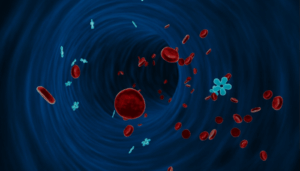The idea of health is so familiar that many of us have never thought deeply about what it is. In fact, defining health has been a difficult task for much of human history.
Most of us would probably define health as “the absence of disease.” However, this definition would be highly inaccurate and dangerously misleading.
Those interested in achieving optimal health, sustaining it across an entire lifetime, or greater longevity must understand what health is accurately.
It is a prerequisite to understanding better and evaluating healthspan and longevity strategies, practical routines, and products.
This chapter summarises chronologically milestones throughout human history in defining what health is. It starts with ancient societies and concludes with our present-day definition at Avea.
In this article
Early Conceptions: Health is a Gift from the Gods
Early conceptions of health in many ancient societies were often linked to religious beliefs and practices. In many cultures, people believed good health was a gift from the gods or other supernatural forces and that illness or disease was a punishment for wrongdoing or displeasing the gods.
To maintain or restore their health, people would often make offerings or sacrifices, go on pilgrimages to holy sites, or engage in other forms of religious practice. This view of health as closely tied to the divine was prevalent in many ancient cultures, including those of the Greeks, Romans, Egyptians, and Babylonians.
5th Century to 1948: Health is Absence of Disease
During the period known as the Scientific Revolution – which took place from the 16th to the 18th century – advances in scientific knowledge and technology led to a more systematic and empirical approach to medicine, with a focus on understanding the underlying causes of disease and developing treatments based on evidence and observation.
The word “health” has its origins in Old English. This language was spoken in England around the 5th century until the Norman Conquest in 1066. The Old English word for health was “hǣlth.”
It had a wide-ranging definition, which included physical wellbeing and spiritual and mental wholeness. It described a state of being that was complete and free from illness or injury and suggested a sense of balance and harmony across different aspects of a person’s life.
However, despite advances in scientific understanding of the human body, the concept of health remained unclear until 1945, when officials from 51 countries gathered to create the United Nations just following World War II.
One of the UN’s early priorities was to address the health needs of people worldwide, particularly in the aftermath of the war.
As part of this effort, the UN created a specialized agency, the World Health Organization (WHO), to coordinate international health efforts and promote better health outcomes for people worldwide.
The WHO’s constitution, which included its definition of health, was ratified by UN member states on April 7, 1948. It defined health as:
“Health is a state of complete physical, mental, and social wellbeing, and not merely the absence of disease or infirmity.”
1986: Health is a Resource
In 1986, WHO released a report titled “Ottawa Charter for Health Promotion”[1]. It emphasized a broader view of health that included not just the absence of disease but also the extent to which an individual can adapt to the social, economic, and environmental factors that impact their health. It augmented the 1948 definition to read:
“A resource for everyday life, not the objective of living.”
Simply put, health was defined more broadly as the body’s ability to function properly and meet the daily demands placed upon it through necessity (e.g., work) and choice (e.g., sports.)
In the case of sports, adaptation over time enables you to run longer distances if you train to be a long-distance runner. Becoming a better chess player would be a demand, requiring cognitive adaptation.
1986: Health is a Resource
In 1986, WHO released a report titled “Ottawa Charter for Health Promotion”[2]. It emphasized a broader view of health that included not just the absence of disease but also the extent to which an individual can adapt to the social, economic, and environmental factors that impact their health. It augmented the 1948 definition to read:
“A resource for everyday life, not the objective of living.”
Simply put, health was defined more broadly as the body’s ability to function properly and meet the daily demands placed upon it through necessity (e.g., work) and choice (e.g., sports.)
In the case of sports, adaptation over time enables you to run longer distances if you train to be a long-distance runner. Becoming a better chess player would be a demand, requiring cognitive adaptation.
Today: Health is Dynamic Buffer Size Maintenance Capacity
Suresh Rattan, a biogerontologist and professor of molecular biology at Aarhus University in Denmark, has made significant contributions to biogerontology by developing novel theories and approaches to studying aging.
He has taken the homeodynamic view of health further, stating:
“Health is the maintenance of the ‘homeodynamic space'”
It refers to the ongoing capability to keep a survival buffer against various stresses, allowing us to live and meet the demands of our environment.

A biogerontologist is a scientist who specializes in the study of aging and the biology of aging. Biogerontologists investigate the underlying mechanisms contributing to aging at the molecular, cellular, and organismal levels. They also study the effects of aging on various physiological systems and the relationship between aging and age-related diseases.
The larger the ‘homeodynamic space,’ the greater our health. Measurable biomarkers, reflecting the size of the space, include robustness and resilience.
Robustness refers to the ability to maintain relatively normal behaviour despite changes from external conditions like the environment (such as temperature) or internal conditions (such as gene mutations.)
Resilience is the process of adapting to and successfully coping with various stressors.
One way to understand the difference between robustness and resilience, although not perfect, is to consider it in the context of exercise.
Robustness refers to the amount of physical activity our body can handle effectively. On the other hand, resilience is either how quickly we can recover from the physical stress caused by exercise or the speed at which our body adapts to the workout program over time.
At AVEA: Summary and Our ‘What is Health Definition’
The following ‘what is health’ definition would provide a summary of what we’ve covered so far in this article:
Health is a state of optimal physical, mental, and social wellbeing and functioning, where an individual can adapt and cope with the demands of daily life and maintain homeostasis, or a stable internal environment, in the face of internal and external challenges. This definition recognizes the complex interplay between biological, psychological, and social factors contributing to overall health. It emphasizes the importance of maintaining balance and resilience across multiple health domains. It also acknowledges that health is a dynamic and multifaceted concept that evolves over time in response to various influences and stressors.
However, it’s long and unwieldy. At AVEA, we’ve shorted it down to this much more manageable definition:
Health means feeling good in your body and mind, being able to handle daily challenges, and being able to adapt to changes. It’s not just about not being sick; it’s about feeling your best.
References







